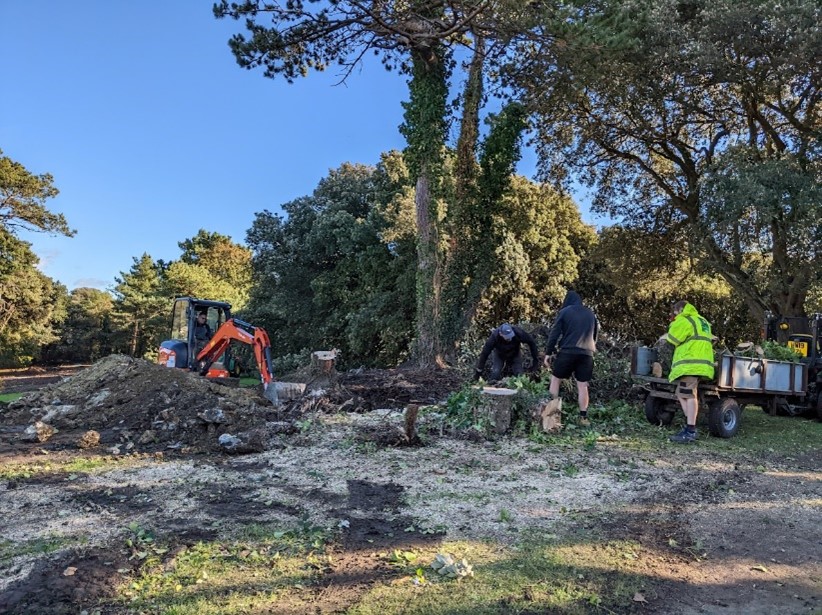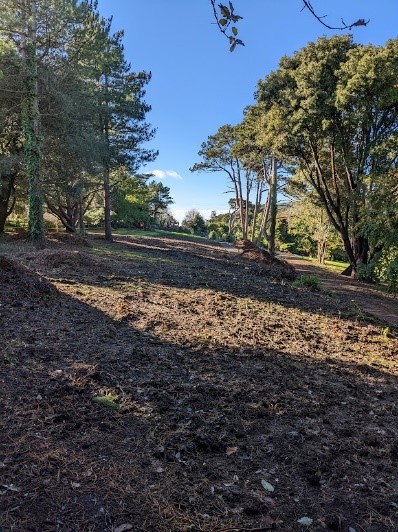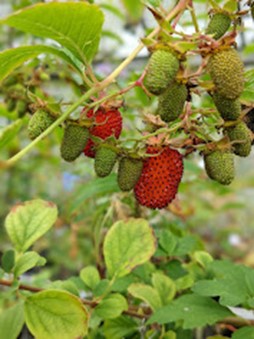Further East Members’ Project
Update
In October 2022 we began the next phase of expansion of the Living Collection from the climatic regions of the Far East that match VBG’s microclimate. The project is entitled Further East; firstly, as it continues east of the Japanese terraces, and secondly because global attention is pivoting toward Asia in the 21st century. Further East in the largest Garden project undertaken since the Westgate Project in 2008 that established the Arid Garden as we know it today and it is the first project funded by Members, our Annual Passholders.
An Overview from the Curator.
The next phase of development at Ventnor Botanic Garden
The Project is part of the Botanic Direction for VBG. Kidd, C. D. A. (2020) (unpublished), extracts of which appeared in Ventnorensis (2021):
The shallow, north-facing valley side of VBG has been under-utilised and has become an exceptionally deep windbreak with little or no new planting of value since 1972. This is because the focus has been on the greater valued south-facing side of the valley. With the south sides fully designated, the opportunity to develop the north using the principles developed on the south is clear. The opportunity to determine up to 30% of the garden area of Ventnor Botanic Garden is a rare one, and one should give consideration to many principles beyond the plant makeup, such as garden flow, the potential for a “big picture” landscape with avenues and sub-partitions, functional spaces etc. Give consideration to inclusivity for all visitors in a topographically challenging area. The value of the windbreak is overstated, pure southerly gales are rare (Watts pers. comm.) and their potential for destruction to leeward is less than the south-westerlies and south easterlies.
The windbreak should be limited to the immediate margins of the Coastal Path and create a dark backdrop.
We should evaluate the success of Magnolia Avenue, there are suspicions about soil depth and summer drought stress evident for some of the Chinese trees that traditionally like a deep loam. Maybe relocate eastwards? Some research into the origins of far eastern Magnolia would be helpful, with a view on replacement with hotter provenance material that may/may not be in cultivation. There is the apparent pressure with the immediacy of planting and fulfilling expectations, champions don’t happen overnight and nobody buys success, losses on the road to Championship Trees are high, over 90% for examples of Eucalyptus elsewhere in the Garden.
To alleviate these issues, we will consider interplanting with crowd-pleasing Hamamellis (Witch Hazel). Pseudolarix amabilis would work very well in the short term as an Autumn showcase plant, but it will not thrive as global heating accelerates.
Within the next few years, there should be gradual west-to-east removal of windbreak trees. Arguably replace Magnolia Avenue, and re-populate with very large Far Eastern species and cultivars for a 50-year maturity horizon, interplanted with immediate impact shrubby cultivars. Extend Camellia collection was permissible for a 25-year maturity horizon. We will give priority to Asian new wild provenance stock we can grow from seed or source.
Extend gardenesque planting eastwards using commercial ornamental plants supporting a half-hardy Far Eastern ethos. Combine with new accessions of wild origin where possible, combined with high-risk half-hardy plants. This area of VBG has fewer champions than anywhere else and no National Collection members giving us a good canvas to start with. We will rename the whole area as Japanese Terrace is no longer appropriate and has been a long irritating misnomer.
Discover where the Further East Project started – HERE.

Removal of Holm Oaks
Nineteen Holm Oaks have been removed from the north facing slope above the arboretum style planting south of the Fountain. Holm oaks are first recorded as being established in considerable number in the wild on the south face of St Boniface Down in 1924. (Flora of the Isle of Wight, Pope, Snow & Allen 2003). Over the ensuing 98 years Holm oaks have behaved as an invasive alien and rapidly became climax vegetation snuffing out the orchid-rich grassland with their profuse phytotoxic leaf litter. At VBG these weed or invasive trees were allowed to grow up after the Great Storm of 1987. They never formed part of the windbreak as storms tend to arrive from the southwest or east, not the south.
As a result of Phase 1 we have a new parkland vista and the first blank canvas for extending the Living Collection since 2008.
A series of mature Victorian era black pines have been uncovered by removal of the Holm Oaks and they form a sculptural frame for the new planting.
Using diminishing spacing to accentuate the distance of the vista, a technique called a forced perspective, we will plant notable Asian trees in pairs either side of the open space.

Impact of the Project
An updated map for the 2023 season will include a new route around the Garden which starts at the Childrens’ Playground which is being re-landscaped, past the Fast Forest, up the track to the Torii Gate, across the top of the Japanese Terraces to the Canadian buoy and then east across new open space to the original Dr. Henry Behrend Walk signpost.
For 2023 visitors can expect flowering shrubs extending the current run of camellias on the lower sections of the bank. Our aim is to select plants and shrubs that flower earlier in the spring than our other Collections to create an earlier start to the spring colour at VBG.

New Accessions
Further East is bringing in over 360 new accessions, many of which are new to cultivation in Europe and the U.K. One example is Rubus fraxinifolius, VBG Accession Number 22-0776 (Mountain Raspberry) from Taiwan which grows from lowland areas up to 3,000 meters.
To date 73 new accessions have been added to the Accessions Database.
